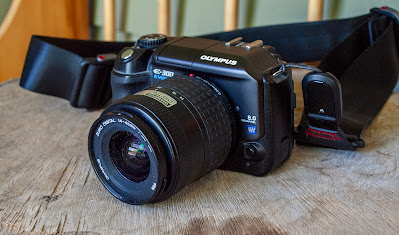Olympus launched their first DSLR, the E-1, to much fanfare in 2003. Not only was it the first DSLR from Olympus, it was the first interchangeable lens system camera designed from the ground up for a digital sensor, rather than being adapted from a film camera.
Unlike Canon and Nikon, Olympus didn’t have a huge installed user base of autofocus lens owners they had to lure to digital, so they started with a clean sheet of paper for their sensor and lens mount.
As part of the Four Thirds consortium, along with Kodak, Panasonic, and Fuji, they used a smaller sensor, which would be less expensive, an important factor in those days when image sensors were still phenomenally spendy. The E-1 had a ruggedized, weather-sealed magnesium alloy body, an innovative ultrasonic vibrating sensor cleaning mechanism, and resolution equivalent to or better than the contemporary Canon EOS-1D and Nikon D1X despite only costing $1699 (about 2800 bucks in 2023 dollars).
Almost simultaneous with the launch of the Olympus E-1 came the next shot fired in the DSLR wars, from Canon, who announced a stripped down consumer DSLR with a plastic body shell for under a grand. The 6.3MP EOS 300D, sold in the US as the Digital Rebel, hit shelves for $999 with a bundled 18-55mm kit lens. Olympus returned fire in 2004 with their second DSLR, a consumer-grade 8MP camera named the E-300, which sold for $999 with a Zuiko 14-45mm f/3.5-5.6 lens included in the box.
The E-300 had three selectable autofocus points, had an ISO range of 100-400 (expandable to 800 or 1600, but don't bother), shutter speeds up to 1/4000th of a second, and could shoot 2.5 frames/sec...at least for four frames, at which point the buffer was filled.
Despite the lack of a viewfinder hump (due to its odd Porro finder system) and small Four Thirds sensor, the E-300 wasn't meaningfully smaller than its competition from Canon, although it offered more megapixels for less money.
Part two of this review will have some photo results and conclusions!
.










